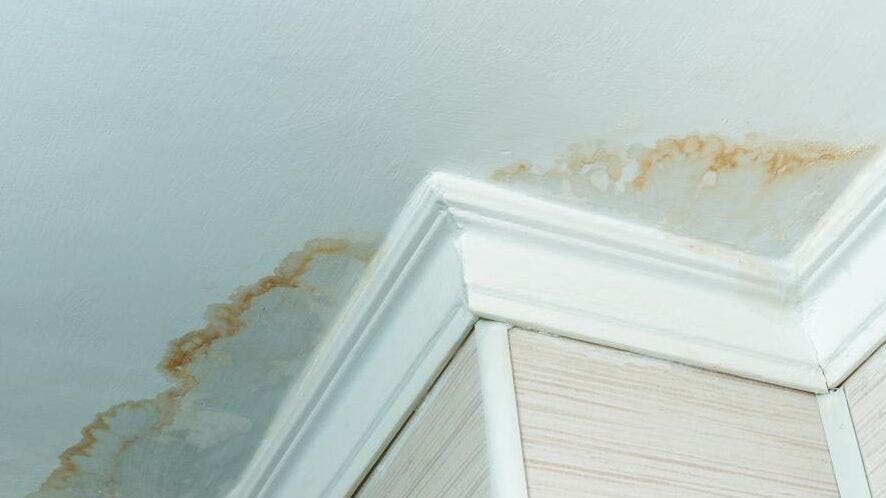A roof that leaks water is a problem that a lot of people don’t plan for. If your ceiling leaks, you shouldn’t ignore them. Do something right away if droplets come through the roof or even if damp, soft water spots show up on the surface. If you don’t fix ceiling water damage, it can turn into mold and damage the structure, making the area unsafe to be in.
Here are some of the most common signs of water damage in the ceiling, what you can do to stop the problem from getting worse, and when you should call in pros to fix and fix up ceiling leaks.
What To Do if Water Leaks From the Ceiling
- Water harm is more likely to happen if a leak lasts for a long time. If there is a water leak or damage from water on your home, follow these steps to lessen the damage.
- Switch off the water: To stop a leak, the first thing you should do is cut off its source. Close the main water valve to do this. The leak should stop when you turn off the water until a professional comes. If the leak is caused by the weather, however, turning off the main opening won’t help.
- Get the chairs out of the way: To keep personal items from getting badly damaged by water, it’s best to move them or cover them with a tarp. This includes things like gadgets, rugs, curtains, and furniture.
- Stop the harm by catching the water: Put buckets or other big containers under the ceiling leak to catch the water that is dripping.
4 Signs of a Leaking Ceiling
When there is a roof leak, the damage from water is usually easy to see. If there are water spots, water dripping from the ceiling to the floor, or sagging ceiling tiles, it’s a clear sign. But what if the signs aren’t so clear?
Below are some common signs of ceiling water damage. If any of the following signs appear, it’s crucial to stop the water leak right away to prevent further water damage.
Stains or Watermarks
Watermarks can be rusty or brown, and they can look like rings around light sources. This could also be shown by stains that look like they are dripping down from the top of a wall where it meets the ceiling.
Signs of Mold
Mold grows where there is a water leak or a problem with high wetness that isn’t fixed. For mold fungus to grow, it only needs 48 hours of being wet.
Mold can be easier to spot if you know how it looks in different situations. This is what mold might look like:
- White, green, black, grey, yellow, light orange, or pink in colour.
- Slimy, fuzzy, powdery, or wool-like in texture.
People and pets may experience symptoms of mold exposure, like allergy and asthma flare-ups or unresolved, lingering coughs.
Sweating and Swelling
When there is a leak, water can build up in the ceilings, doors, walls, windows, and floors. Because of the high moisture content, people often sweat or swell. In this case, look for these things:
- Beading water droplets on ceilings and walls
- Doors not closing properly due to swelling
- Bubbling paint
Why Does Water Leak Through Ceilings?
It can be stressful to try to figure out where a water leak is coming from without the right tools and advice. Pipes, vents, bathroom fixtures, gutters, and roof problems are some of the most common reasons why ceilings leak.
Damaged Pipes
One common reason for ceiling leaks is lines that are broken. Many things can cause water and waste lines to leak, such as:
- Pipes rust and wear as they age, which may cause cracks and holes.
- Cold weather may cause pipes to freeze and then burst.
- Clogged pipes may cause pressure to build up, forcing pipes to crack.
- Pipes may be damaged from renovations.
Leaking Shower or Bathtub
If there is a bathroom right above where the roof or floor is leaking, that’s where the problem is. Water leaks can happen in pipes, sinks, toilets, and baths. Some examples of places where shower and bathroom leaks come from are
- Cracks
- Drain leaks
- Overflow
- Worn seals
When To Call a Professional
Even minor water leaking from the ceiling can lead to extensive water damage and mold. Your best course of action after the leak is identified is to contact a professional water damage remediation expert at a local Rainbow Restoration.
Our team of IICRC-certified service professionals has the knowledge and tools to restore your home or business, mitigating and remediating damage from any ceiling leak. Don’t wait and allow water damage to spread and risk mold growth.
Call for emergency service or request an appointment online to get started now.

